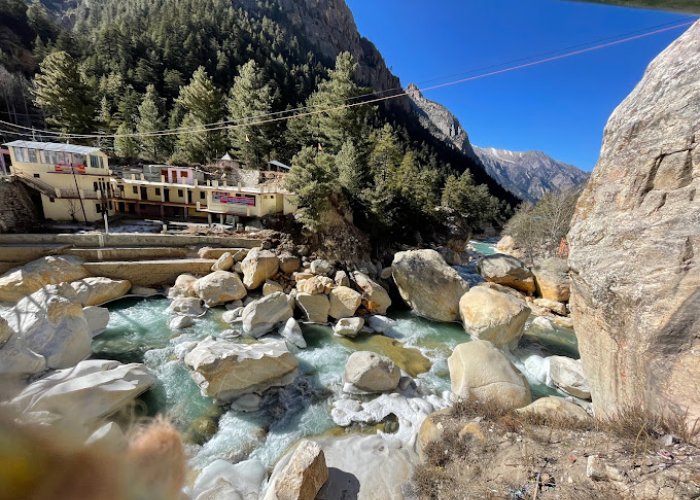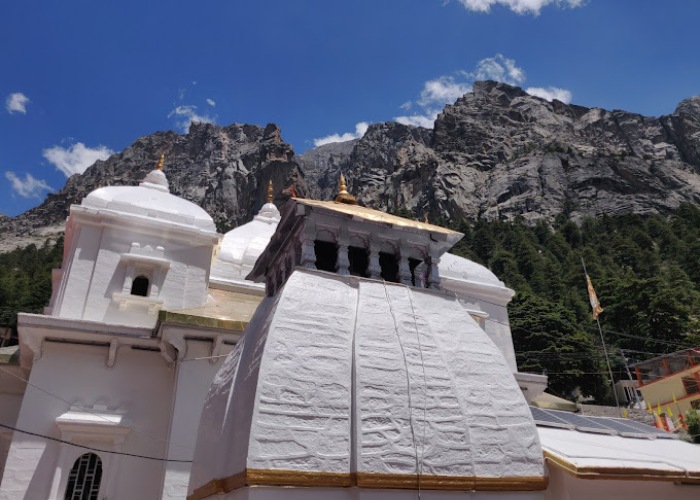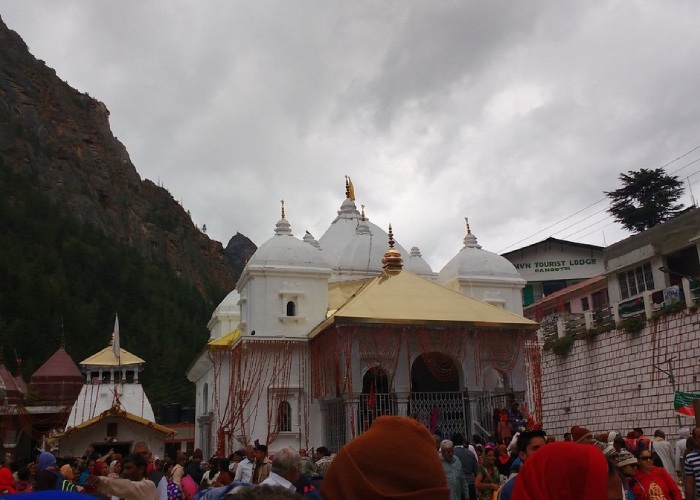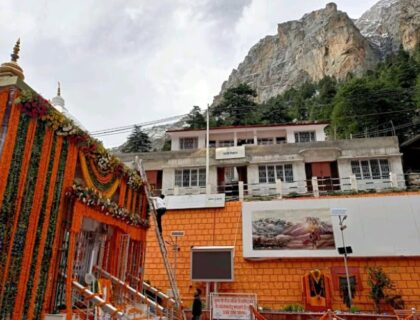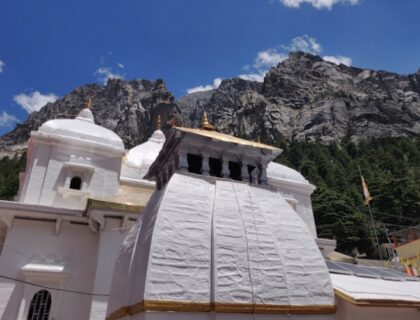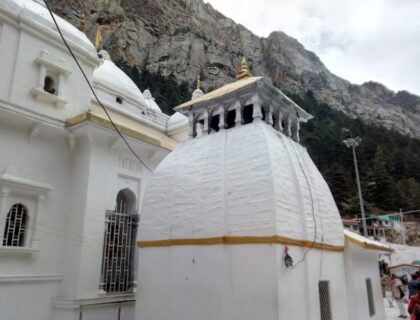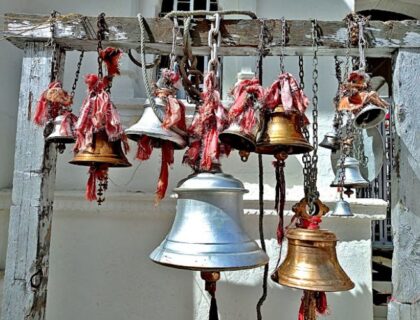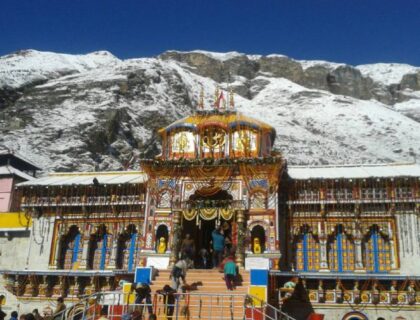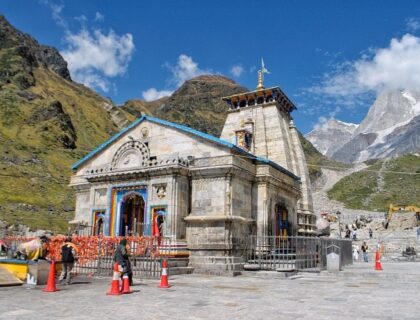Gangotri Temple
Gangotri Temple is a Hindu pilgrimage site dedicated to Goddess Ganga that is situated near a sacred stone where King Bhagiratha worshipped Lord Shiva. This temple is one of the most important temples dedicated to Goddess Ganga, as well as one of Uttarakhand’s four Chota Char Dham Yatra pilgrimage sites.
The temple is surrounded by Deodar and pine trees in the Greater Himalayan Range. Along with Gangotri Temple, the holy river Bhagirathi flows. Ganga Maa (mother), a Hindu deity, originates from the Gangotri glacier at Gaumukh, about 18 kilometres from Gangotri town. Goddess Ganga is said to have come to earth to wash away the sins of King Bhagirathi’s ancestors.
Special Significance of Gangotri Temple
Gangotri is one of four pilgrimage sites on the Chota Char Dham circuit. It is also the source of the Ganges River and the residence of the goddess Ganga. The river is known as Bhagirathi at its source and Ganga (the Ganges) from Devprayag onwards, where it meets the Alaknanda. The holy river’s source is at Gaumukh, which is located in the Gangotri Glacier and is a 19-kilometer trek from Gangotri. Amar Singh Thapa, a Nepalese general, built the original Gangotri Temple.

Every year, the temple closes on Diwali and reopens on Akshaya Tritiya. During this time, the goddess’s idol is kept in Mukhba village, near Harsil. The Semwal family of pujaris oversees the temple’s ritual duties. These pujaris are from the village of Mukhba.
History of Gangotri Temple
The Ganga, the river of life, made its first appearance on Earth in the Himalayas. The Gangotri shrine, dedicated to the Goddess, can be found along Bhagirathi’s right flank. Amar Singh Thapa, a Gorkha commander, built the Gangotri temple, which stands at 3042 metres, in the early 18th century.

According to Hindu sacred texts, “after King Bhagiratha’s centuries-long penance, Goddess Ganga assumed the form of a river to atone for the misdeeds of his forefathers.” Lord Shiva wrapped her in his matted hair to soften the impact of her fall. She was given the name Bhagirathi in her mythological origin.” There are numerous legends associated with Gangotri’s history. Legend has it that Ganga, a beautiful and vivacious young woman, was born from Lord Brahma’s kamandalu (water vessel). There are two stories about Ganga’s birth. According to legend, after defeating the demon Bali, Brahma washed Lord Vishnu’s feet.
Architecture of Gangotri Temple
A Goddess Ganga temple is located near a sacred stone where King Bhagiratha worshipped Lord Shiva. According to Hindu Sacred books, Goddess Ganga took the form of a river to atone for the sins of King Bhagiratha’s forefathers after his centuries-long penance. King Bhagiratha meditated on Bhagiratha Shila, a sacred slab. At this location, Ganga is said to have made contact with the earth. Another legend has it that the Pandavas performed the great ‘Deva Yagna’ here to atone for the deaths of their kin in the epic battle of Mahabharata.

Gangotri’s gleaming white temple is a humble and simple Hindu temple that appears to have been built quickly. It is a stunning contrast to the breathtaking blue-green backdrop and is extremely eye-catching due to its own charm. During the 18th century, the Gurkha general Amar Singh Thapa was responsible for constructing this temple in a traditional North Indian architectural style and design. Unlike its counterpart temples, which feature fine engravings and carvings, this 20-foot-high temple is made entirely of gleaming white granite. The temple is crowned by three main cupolas with golden spires and a few smaller ones.
Important Facts about Gangotri Temple
- The Gangotri Temple, located at an elevation of 3048 metres and surrounded by all the prettiest exquisiteness and elegant surroundings, is one of the most important pilgrimages for devout Hindus and emits a highly pious aura.
- Hindus believe that performing ancestral rites on the banks of the Bhagirathi frees the ancestor’s spirit from the cycle of rebirth and that a holy dip in its waters cleanses sins committed in both current and previous births.
- The Gangotri temple opens on the auspicious day of Akshaya Tritiya, which occurs in May and closes on Yama Dwitiya or Bhai Dooj, which occurs in November. For the next six months, the Gangotri temple will be closed.
- During the winter, the Goddess relocates to the village of Mukhba. Ganga Dussehra, the day of Ganga’s birth, is celebrated with great fanfare in the month of May.
- A bath in Ganga’s sanctified waters is said to cleanse all sins and protect against an untimely or painful death. Ganga Devi (goddess) is regarded as a deity in Hinduism due to her strong associations.
- The Ganges River originated at the Gaumukh from the Gangotri glacier. The Gangotri temple is located on the banks of the Bhagirathi River.
- Its divine and serene atmosphere is created by its location among lofty Garhwal Himalayan peaks, glaciers, and dense forests.
- Gangotri Dham is one of the four Char Dham pilgrimage sites. Most people prefer a complete Char Dham Yatra that includes all four adobes, but some prefer individual trips to all four locations.
- Travelling in monsoons is not recommended due to the risk of landslides, floods and other rain-related issues.
Best Time to Visit Gangotri Temple
The months of April to June and September to November are ideal for visiting Gangotri. From the last week of April to the second week of November, the temple is open. The weather in Gangotri is pleasant all year. Summers in Gangotri are pleasant, but winters are much colder.
Famous Festivals In Gangotri Temple
-
Akshay Tritya – On this day, devotees return Ganga’s idol from her winter home of Mukhwa. They clean the temple and decorate it with flowers. The Goddess Ganga idol is then placed in the main sanctum. The ceremony is accompanied by songs and dances performed by devotees.
- Diwali – The temple closes after Diwali celebrations. Devotees bring Ganga’s idol to the Mukhyamath Temple in Mukhwa’s small village of Mukhwa. Goddess Ganga spends the winter at this temple. On this day, the people of Mukhwa clean the entire village in preparation for the arrival of the Goddess.
- Ganga Dussehra – This festival commemorates the arrival of Goddess Ganga on Earth. Thousands of pilgrims from all over the country take a holy dip in the Ganga. In the evening, there is also a beautiful Ganga Aarti. Devotees offer flowers and sweets to the Ganga river. The sacrifice is made in leafy boats that float down the river.
How to Reach Gangotri Temple
By Air: Jolly Grant Airport, Rishikesh Road, Dehradun, is the nearest airport to Gangotri. Hire a cab or get a bus from here.
By Rail: The nearest railway station is in Rishikesh, about 249 kilometres away, from which one must hire a cab or take a luxury bus to Gangotri. Rishikesh is not well served by fast trains, and Kotdwar has a limited number of trains. If you are travelling by train to Gangotri, Haridwar is the best railway station to use. Many trains run to and from Haridwar from all over India.
By Road: Gangotri is easily accessible by road from most major cities in Uttarakhand, Uttar Pradesh, Delhi, and the National Capital Region. It is 452 kilometres from Delhi and 229 kilometres from Rishikesh.
Also Read – Yamunotri Temple
Location
Facilities
- Drinking Water
- Pooja Item Shops
- Prasad Shops
- Resting Room


